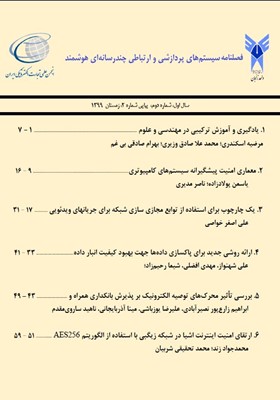ارتقای امنیت اینترنت اشیا در شبکه زیگبی با استفاده از الگوریتم AES256
محورهای موضوعی : پردازش چند رسانه ای، سیستمهای ارتباطی، سیستمهای هوشمندمحمدجواد زند 1 , محمد تحقیقی شربیان 2 *
1 - دانشکده مهندسی برق و کامپیوتر ، موسسه آموزش عالی روزبه زنجان ، زنجان ، ایران
2 - دانشکده مهندسی برق و کامپیوتر ، دانشگاه آزاد اسلامی واحد زنجان ، زنجان ، ایران
کلید واژه: اینترنت اشیا, امنیت, رمزنگاری, محرمانگی,
چکیده مقاله :
اینترنت اشیا مفهومی جدید در صنعت فناوری اطلاعات است که آینده ای جدید از اینترنت را با تلفیق نمودن کاربران، سیستم های محاسباتی و تمام اشیا روزمره فراهم می آورد. مسئله این است که توسعه واقعی این سرویس ها به سطوح ارتقاء یافته امنیت و حفظ محرمانگی نیاز دارد. برای اطمینان از محرمانه بودن اطلاعات حین انتقال داده ها، عمومی ترین روش رمزنگاری داده ها است . در این مقاله ابتدا چالش های پیش روی در امنیت اینترنت اشیا ، شامل حجم انبوه اطلاعات و ارتباطات میان سخت افزار سیستم ها، بررسی شده و چالش امنیتی مورد هدف قرار گرفته است . سپس ضمن بررسی و تشریح روش رمزنگاری متداول AES128 که در پروتکل های اینترنت اشیا از آن استفاده می شود، فرایند ارتقای این روش به بالاترین سطح امنیتی این الگوریتم یعنی AES256 و پیاده سازی و شبیه سازی عملکرد آن بر روی بسته اطلاعاتی انجام شده و نتایج حاصل از این ارتقاء و خروجی های مورد نظر جهت تحلیل و مقایسه روش پیشنهادی نیز با استفاده از نرم افزار متلب تولید و بیان می گردد .
Introduction: The Internet of Things is a new paradigm in the information technology industry that provides a new future for the Internet by integrating users, computing systems, and almost all objects. ZigBee technology is one of the most popular wireless technologies used to connect Internet of Things devices. This technology creates a hierarchical network to enable a number of devices to communicate with each other. The development of services based on the Internet of Things requires improved levels of security and confidentiality. To ensure the confidentiality of information during data transmission, the most common method is data encryption. Lightweight cryptography has been proposed as a concept for managing security in resource-constrained devices, which are the major constituent of the Internet of Things. Lightweight cryptography is based on conventional cryptography principles but aims to design algorithms with little hardware and software footprint. The concept of style extends to methods of decoding and maintaining a balance between performance, security, and cost of algorithms. In this article, the AES algorithm is evaluated as a lightweight algorithm.Method: In this article, an encryption method with a 256-bit symmetric key with AES standard is proposed, and the information packet that includes application data and authentication information is encrypted and then decrypted by the proposed algorithm Both AES128 (common) and AES256 (recommended) methods are implemented to improve information security, and the impact of the password size is also analyzed.Results: The proposed method is compared against the legacy AED128 method. The simulation results substantiate that the proposed method reaches a higher level of security by increasing the data decryption time. Even though this improvement has incurred extra computation costs the results show this cost is acceptable.Discussion: In the proposed method of research, compared to the previous methods, an upgraded method in terms of data security has been used to encrypt the input data in such a way that the data extraction cost is increased and an elevated level of the data security is reached, which This is very useful in improving the security of IoT systems.
_||_

